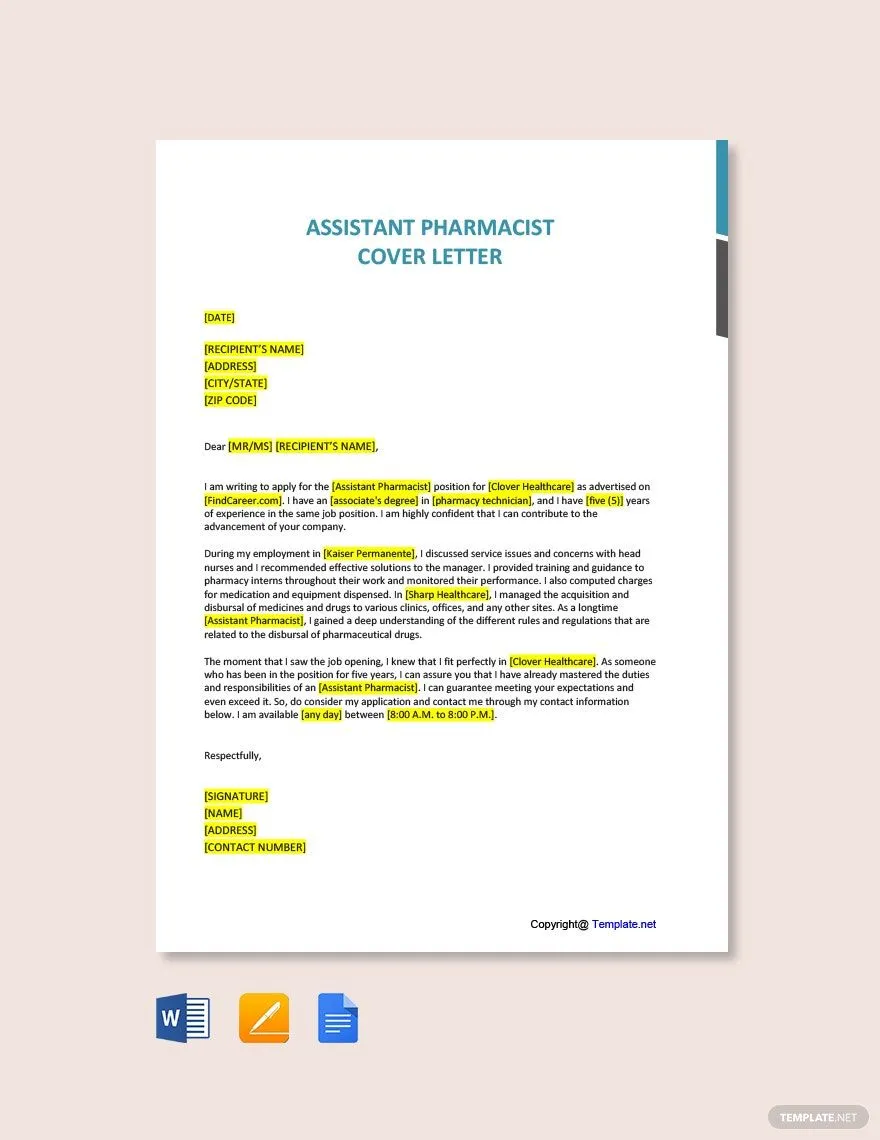Crafting a Compelling Pharmacist Cover Letter
A pharmacist cover letter is your first chance to make a positive impression on a potential employer. It’s a critical tool in your job application arsenal, providing you with the opportunity to showcase your qualifications, skills, and enthusiasm for the position. A well-crafted cover letter can significantly increase your chances of getting an interview and ultimately landing your dream job. This guide provides you with the essential elements and strategies to create a cover letter that stands out and helps you get hired. Remember, this is not just a formality, it’s a marketing document that sells your unique value proposition to the employer.
Understanding the Purpose of a Cover Letter
The primary purpose of a pharmacist cover letter is to introduce yourself, highlight your key qualifications, and express your interest in the specific job. Unlike a resume, which provides a summary of your experience, a cover letter allows you to tell a story, explaining why you are the ideal candidate. It also demonstrates your communication skills and your understanding of the role and the company. The cover letter gives you the opportunity to make a personal connection with the hiring manager and show them why you are a good fit for their team and the specific job requirements. It is a chance to sell yourself and create a lasting first impression.
Highlighting Your Skills and Qualifications
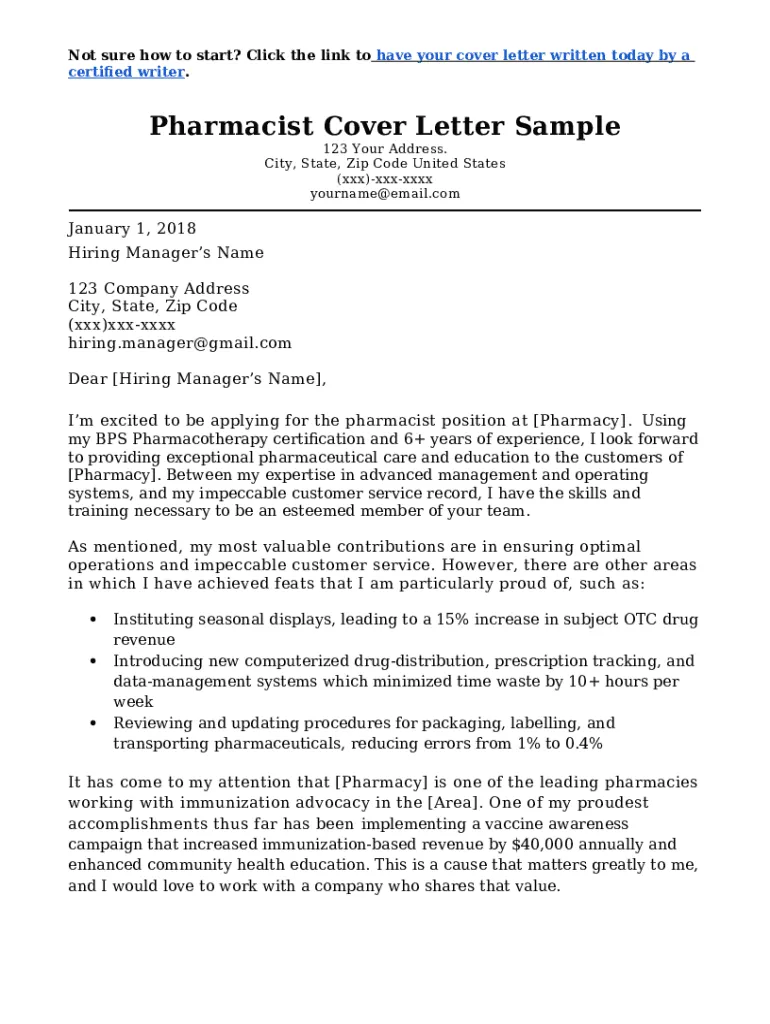
Your cover letter is the perfect place to highlight the skills and qualifications that make you a strong candidate. Focus on the skills mentioned in the job description and provide specific examples of how you’ve used these skills in your previous roles. Emphasize your clinical knowledge, dispensing accuracy, patient counseling abilities, and experience with pharmacy software or systems. Don’t just list your skills; demonstrate them with specific examples of your achievements. For instance, you can explain how you improved patient outcomes, increased pharmacy efficiency, or resolved medication errors. The key is to show, not just tell, the hiring manager that you possess the necessary skills to excel in the role.
Essential Components of a Pharmacist Cover Letter
A well-structured cover letter is easy to read and provides all the necessary information. It should include several key components to ensure clarity and impact. By including these elements, you ensure that you present yourself in a clear, professional manner. Failing to include these elements could decrease your chances of getting the job. Remember, the goal is to make the hiring manager’s job easier by providing them with all the information they need to evaluate your suitability for the position.
Your Contact Information and Date
Begin your cover letter with your contact information, including your name, address, phone number, and email address. This information should be placed at the top left or right corner of the letter. Following your contact information, include the date. Ensure your email address is professional. Consider using a professional-sounding email address to maintain a professional image. This allows the hiring manager to easily reach you if they decide to move forward with your application and schedule an interview.
Addressing the Hiring Manager
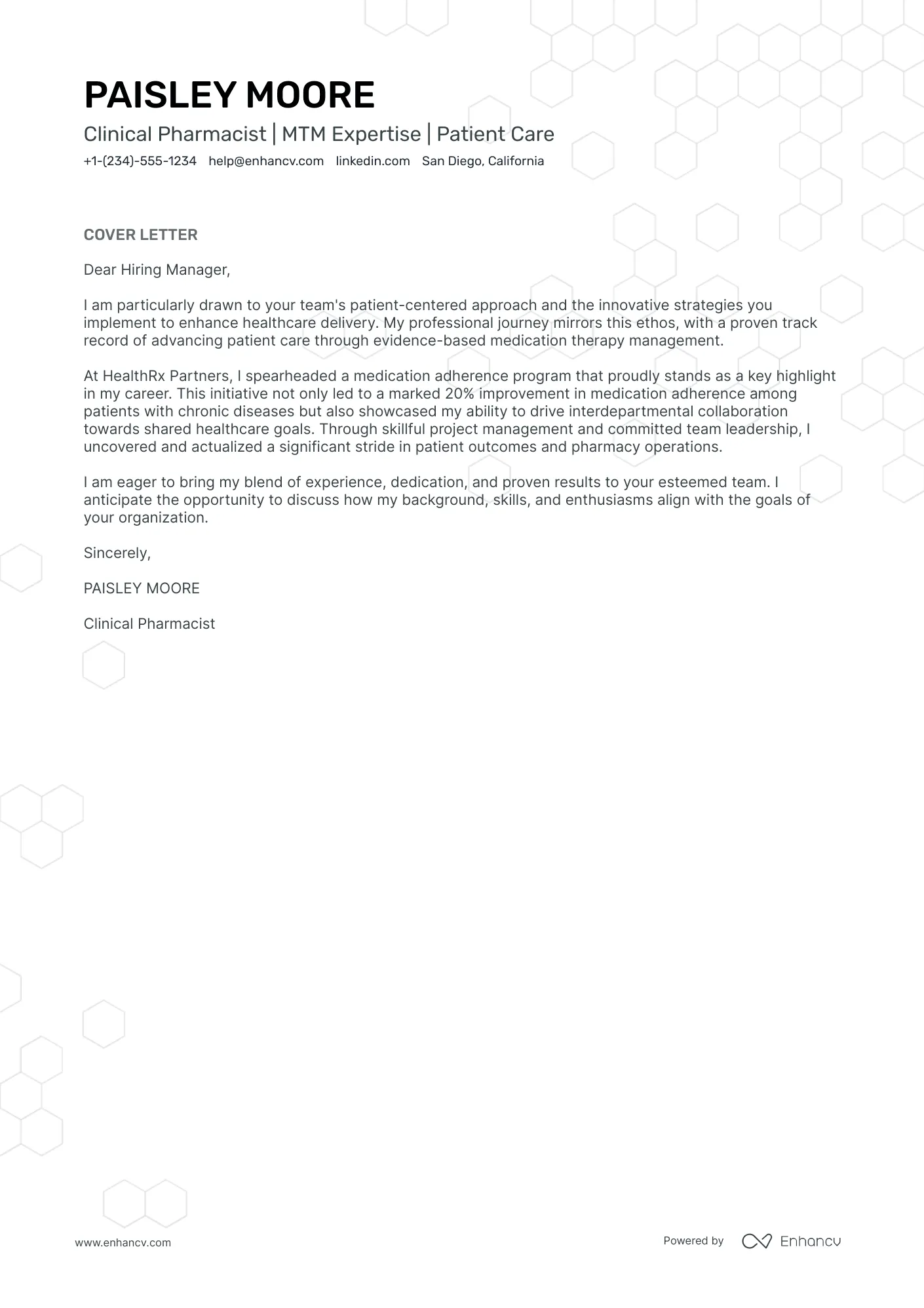
Always address your cover letter to the hiring manager by name, if possible. Research the company or check the job posting to find out who is responsible for hiring. Addressing the letter to a specific person shows that you have taken the time to learn about the company and that you are genuinely interested in the role. If you are unable to find the hiring manager’s name, use a professional greeting like “Dear Hiring Manager.” Avoid generic greetings like “To Whom It May Concern,” which can make your letter seem impersonal.
Writing a Strong Opening Paragraph
Your opening paragraph is your first chance to grab the reader’s attention. Start with a strong statement that immediately conveys your interest in the position and the company. Mention where you saw the job posting and why you are interested in the role. Briefly state your key qualifications and how they align with the job requirements. This paragraph sets the tone for the rest of your letter, so make it engaging and concise. For example, you might start by saying you’re excited about the opportunity to apply your skills at their reputable pharmacy.
Showcasing Your Relevant Experience
The body of your cover letter should highlight your relevant experience. Focus on the experiences that are most relevant to the job description. Explain your responsibilities in previous roles and provide specific examples of your achievements. Use the STAR method (Situation, Task, Action, Result) to describe your experiences. This method helps you provide a clear and concise account of your accomplishments. By using this method, you can demonstrate how your actions led to positive outcomes. Be sure to quantify your achievements whenever possible to demonstrate the impact of your work.
Quantifying Your Achievements

Whenever possible, quantify your achievements to provide concrete evidence of your accomplishments. Use numbers, percentages, and specific data to illustrate your impact in previous roles. For example, instead of saying, “Improved patient satisfaction,” say, “Increased patient satisfaction scores by 15%.” Providing quantifiable results adds credibility to your claims and demonstrates your ability to achieve results. Quantifying your achievements showcases your value and makes your application more persuasive. Think about metrics like prescriptions filled, error reduction rates, or patient counseling satisfaction.
Tailoring Your Cover Letter to the Job Description
Tailor your cover letter to match the specific requirements of each job you apply for. Carefully review the job description and identify the key skills, qualifications, and experience the employer is seeking. Use the same keywords and phrases from the job description in your cover letter to demonstrate that you are a good fit for the role. Customize your letter to highlight the experiences and skills that are most relevant to the specific position. This targeted approach shows the hiring manager that you have taken the time to understand their needs and that you are genuinely interested in the job.
Emphasizing Key Skills
Highlight the key skills that are most important for the role. These could include clinical knowledge, dispensing accuracy, patient counseling, medication therapy management, or experience with specific pharmacy software. Provide examples of how you have used these skills in previous roles to achieve positive outcomes. Make sure your key skills align with the requirements listed in the job description. Showing your skills with examples makes your cover letter more compelling and makes you stand out from the competition. Emphasize both hard and soft skills, such as communication and teamwork.
Demonstrating Your Knowledge of Pharmacy Practice
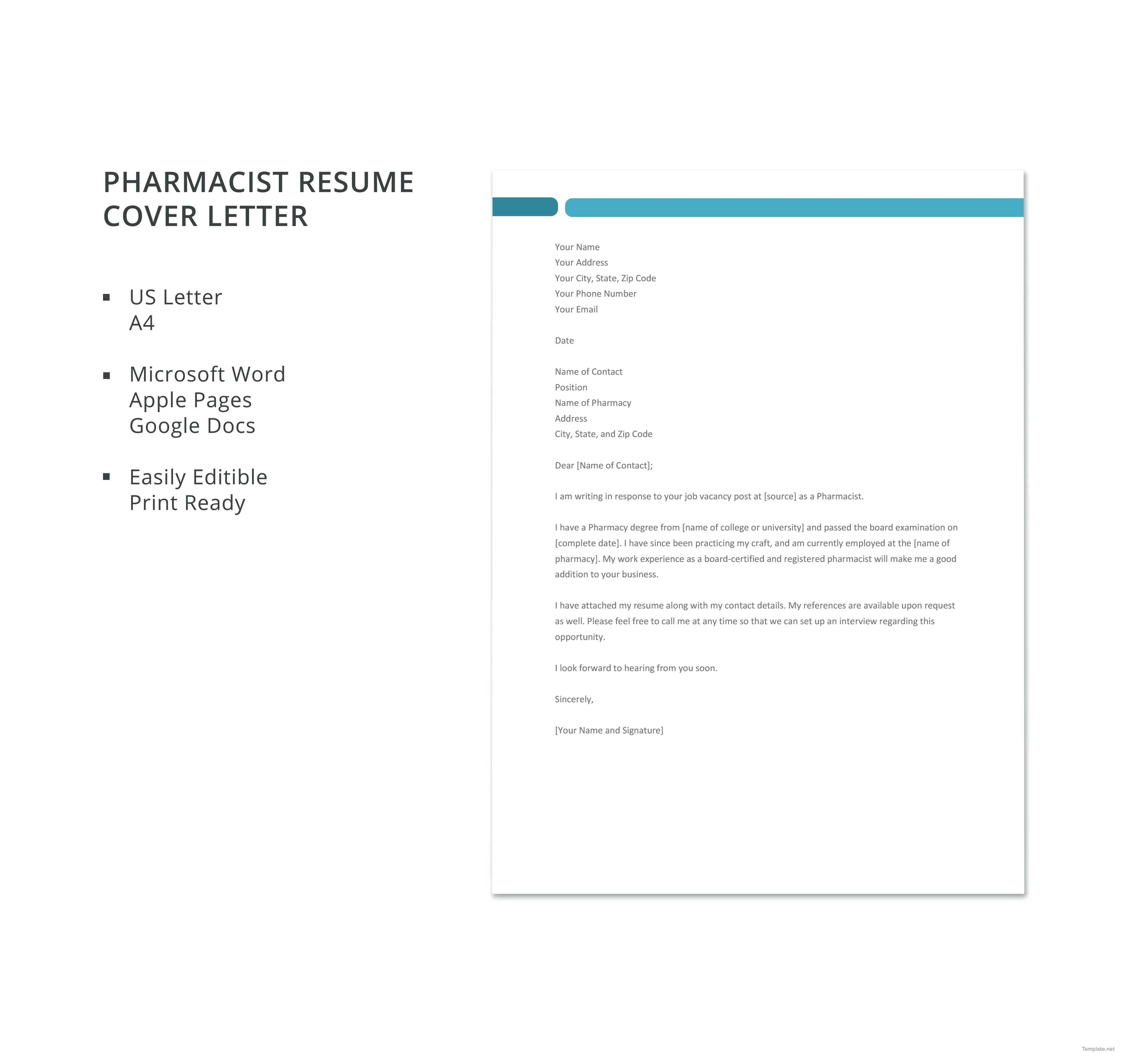
Showcase your knowledge of pharmacy practice and your understanding of relevant regulations and best practices. Mention any experience with quality assurance programs, medication safety protocols, or patient education initiatives. Demonstrate your commitment to patient safety and your ability to contribute to a high-quality pharmacy environment. By demonstrating your knowledge of pharmacy practice, you show that you are not only competent but also committed to the profession and its standards. Reference any relevant certifications or licenses that you hold.
Writing a Powerful Closing Paragraph
Your closing paragraph should summarize your interest in the position and your qualifications. Reiterate your enthusiasm and express your eagerness to learn more about the opportunity. Thank the hiring manager for their time and consideration. Make sure to include a call to action, encouraging the hiring manager to contact you for an interview. A strong closing paragraph reinforces your interest and leaves a lasting positive impression. This is your final opportunity to sell yourself, so make it count.
Expressing Your Enthusiasm and Interest
Express your genuine enthusiasm for the position and the company. Explain why you are excited about the opportunity and how it aligns with your career goals. Mention any specific aspects of the role or the company that particularly appeal to you. Your enthusiasm can make a significant impact on the hiring manager. By expressing your interest, you signal that you are not just looking for a job but that you are genuinely interested in the specific opportunity and the company itself. This can set you apart from other candidates.
Including a Call to Action
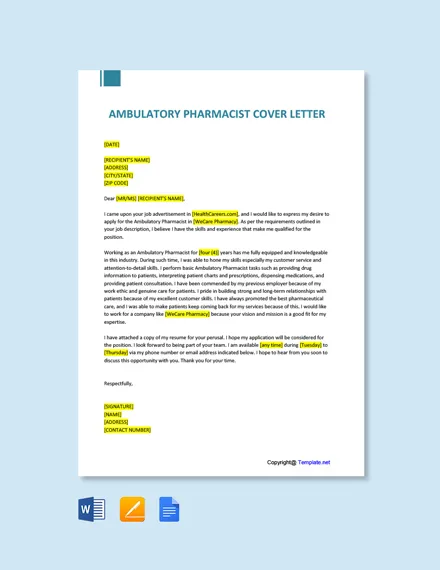
End your cover letter with a clear call to action. Encourage the hiring manager to contact you for an interview. Provide your phone number and email address, and let them know you are available to discuss your qualifications further. This direct approach makes it easy for the hiring manager to take the next step. Including a call to action increases your chances of getting an interview. The aim is to make it easy for the recruiter to contact you and schedule an interview.
Formatting Your Pharmacist Cover Letter
The format of your cover letter is just as important as the content. A well-formatted letter is easy to read and makes a positive impression. Ensure your cover letter is visually appealing and professional. Remember, your cover letter reflects your attention to detail and professionalism. Correct formatting is essential to maintain a high standard and make a positive first impression. An easy-to-read format increases your chances of the hiring manager reading through your entire application.
Font and Font Size
Choose a professional font, such as Times New Roman, Arial, or Calibri. These fonts are easy to read and widely accepted. Use a font size of 11 or 12 points to ensure readability. Avoid using overly fancy fonts or sizes that are too small or too large. These can make your letter difficult to read and detract from your message. By using a simple, readable font, you ensure that the focus remains on your qualifications and skills. Ensure the text is clear and easy for the reader to scan.
Margins and Spacing
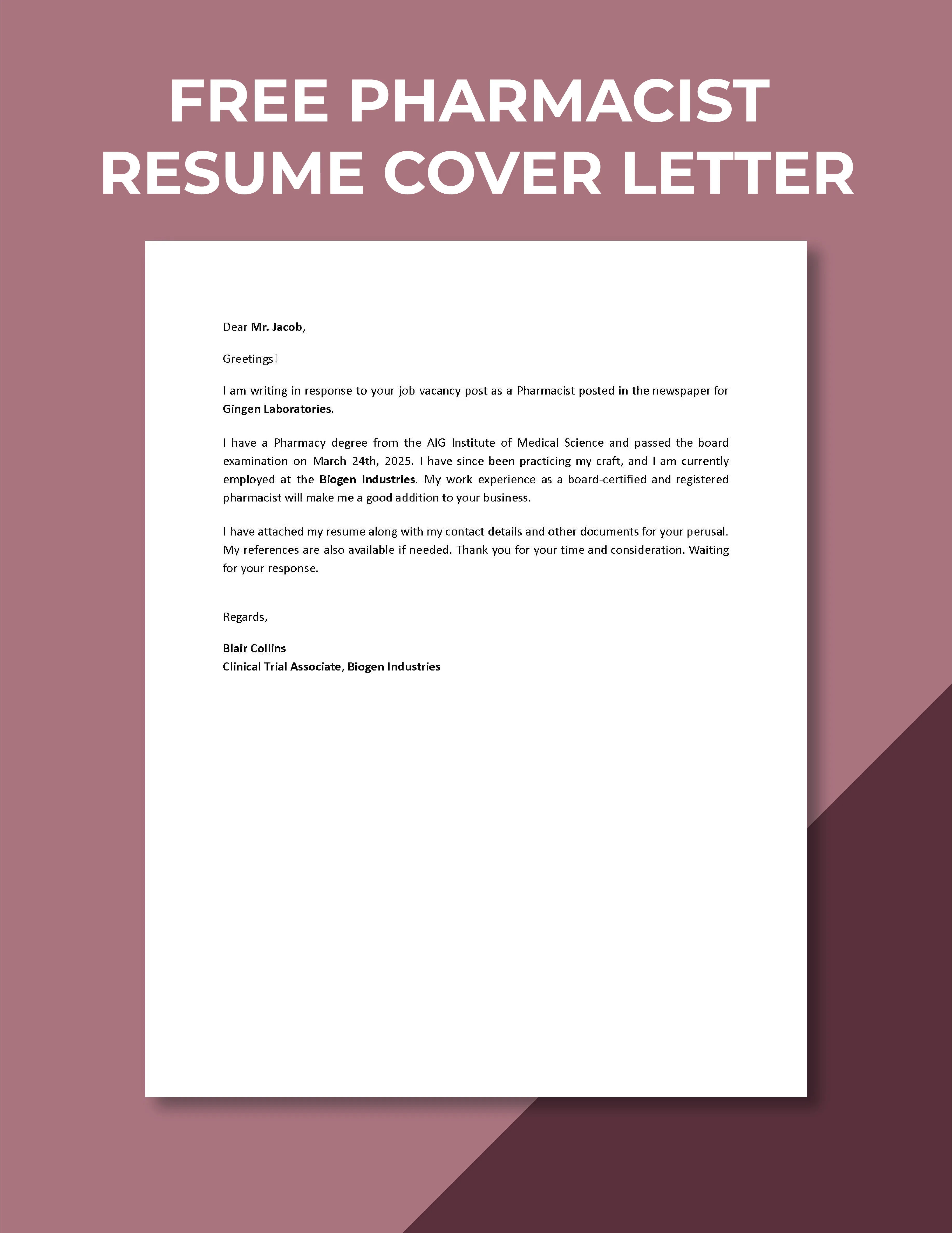
Use standard margins of 1 inch on all sides of your cover letter. This provides enough white space to make your letter easy to read. Use single spacing within paragraphs and double spacing between paragraphs. This creates a clean and organized look. Proper spacing and margins are essential for an appealing and easy-to-read cover letter. The white space prevents the text from appearing crowded, and helps the hiring manager easily digest the information.
Proofreading and Editing
Proofread your cover letter carefully for any grammatical errors, spelling mistakes, or typos. These errors can create a negative impression and detract from your qualifications. Use a grammar checker and spell-checker, but also read through the letter yourself to catch any errors that the software may miss. Ask a friend or family member to review your letter as a second pair of eyes. Ensure that your letter is free of errors to convey a professional image. Proofreading is a crucial step in ensuring your cover letter accurately reflects your skills and experience.
Using a Professional Tone
Maintain a professional tone throughout your cover letter. Use formal language and avoid slang, jargon, or overly casual language. Write in a clear, concise, and professional manner. Your tone should reflect your professionalism and your respect for the hiring manager and the company. By using a professional tone, you create a positive impression and demonstrate that you take your job search seriously. Ensure your language is appropriate for a professional environment.
Tips for a Successful Pharmacist Cover Letter
To maximize your chances of success, keep these additional tips in mind when writing your pharmacist cover letter. These tips will help you stand out and impress potential employers. They will also help you avoid common mistakes. Remember to personalize your cover letter for each job application to increase your chances of success. By following these tips, you can create a cover letter that grabs the hiring manager’s attention and increases your chances of getting an interview.
Researching the Company
Before writing your cover letter, research the company and the role you are applying for. Learn about the company’s mission, values, and culture. Understand the specific requirements of the job and the skills the employer is seeking. This research will help you tailor your cover letter to the specific needs of the employer and demonstrate your genuine interest in the role. Highlighting the company’s values can make your cover letter more compelling. By researching the company, you can customize your letter and show you are serious about working there.
Highlighting Your Accomplishments
Focus on highlighting your accomplishments rather than just listing your responsibilities. Use the STAR method (Situation, Task, Action, Result) to describe your achievements and the impact you had in previous roles. Quantify your achievements whenever possible to demonstrate the value you brought to your previous employers. Providing specific examples makes your achievements more impactful. By focusing on your accomplishments, you showcase your value and demonstrate your ability to succeed in the new role.
Tailoring Your Letter to Each Application
Avoid using a generic cover letter. Tailor your cover letter to each job application. Customize your letter to address the specific requirements of the job and highlight the skills and experiences that are most relevant to the role. Show the hiring manager that you have taken the time to understand their needs and that you are genuinely interested in the opportunity. This personalized approach will make your cover letter more effective. Tailoring your cover letter to each job application shows you care and that you put in the extra effort.
Following Up After Submitting Your Cover Letter
Follow up with the hiring manager or the company after submitting your cover letter and resume. Send a polite email or make a phone call to express your continued interest in the role. Thank them for their time and consideration. Briefly reiterate your qualifications and enthusiasm for the position. Following up demonstrates your initiative and your commitment to the job. This follow-up can help you stand out from the competition and remind the hiring manager of your application. Make sure to follow up within a reasonable timeframe, usually one to two weeks after submitting your application.
